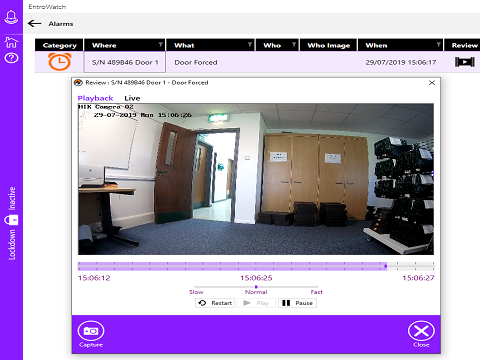What is a Building Access Control System?
26 April 2023

Access control is an essential component of building security and involves the use of various physical and digital systems to restrict and monitor access to a building or specific and controlled areas within it.
The goal is to ensure that only authorised individuals can enter and move around the building, while also keeping track of who is coming and going. Individuals requiring building access can range from employees and sub-contractors, to students and suppliers. There are different types of access control systems, which can be built-into a reliable and effective access control system for your building.
Types of Access Control Systems
There are several types of access control systems available, each with its own benefits and limitations. The most common types are:
1. Physical Access Control Systems
Physical access control systems use physical barriers such as gates, turnstiles, and doors to control entry to a building or specific areas within it. These systems can be controlled manually or automatically using access cards, key fobs, or biometric systems such as fingerprint or facial recognition.
2. Electronic Access Control Systems
Electronic access control systems use electronic devices such as card readers, keypads, or biometric scanners to control access to a building or specific areas within it. These systems are often connected to a central computer system that can monitor and control access to various parts of the building.
3. Network Access Control Systems
Network access control systems are designed to control access to computer networks and the resources they contain. These systems are often used in large organisations to ensure that only authorised users can access the network and its resources.
Building an Access Control System
Building an effective access control system requires careful planning and consideration of several key factors. Here are the steps to follow when building an access control system for your building:
- Assess Your Security Needs: the first step in building an access control system is to assess your security needs. Consider the type of building you have, the level of security required, and the areas within the building that need to be secured. Identify any potential security risks and determine the best ways to address them.
- Choose the Right Access Control System: once you have assessed your security needs, you can choose the right access control system for your building. Consider factors such as the size of your building, the number of users who will require access, and the level of security required. Consult with security experts to determine the best system for your needs. A typical system offered for building security by Remsdaq is the EntroWatch system. This is a complete Eco system that includes 2, 4 and 8-door controllers (EntroStar and EntroNet), card readers, keypads (EntroPads) and request to exit (RTE) buttons, secure credential cards (EntroPass) and the EntroWatch management software.
- Install an Access Control System: working with a Remsdaq approved installer will help in the design and installation of your chosen access control system. The project may involve installing physical barriers such as entrance turnstiles, gates or doors, electronic devices such as card readers and keypads, Bluetooth mobile readers or biometric (fingerprint) scanners, and computer systems to run the access control management software. Additional CCTV cameras can provide a third way to monitor building security, with EntroWatch capable of integrating camera footage into live tile screens and against specific door events.
- Train Your Employees: once the access control system is installed, it’s essential to train your employees on how to use it. Ensure that they understand the different types of access control systems, how to use them, and the importance of keeping access control information confidential. Also at the same time make sure they understand the need to safely store their access control cards, reporting any that are lost and stolen. Access control training can also form part of the general training on the building including the use of emergency exits and muster points.
- Test the System: after installation, it’s essential to test the system to ensure that it is working correctly. Test the system under different scenarios to identify any potential issues and address them promptly.
- Maintain the System: regular maintenance of your access control system is essential to ensure that it continues to function correctly. This may involve upgrading software, replacing hardware, or performing routine maintenance tasks such as cleaning and testing the system.
Further consideration should be given as to how to ‘future-proof’ your access control system. Firmware updates will help to keep the hardware up to date with enhancements and any changes required to comply with the latest cybersecurity requirements. The access control management software could also be subject to updates to provide new futures and meet specific site requirements.
Conclusion
Building an effective access control system is essential for ensuring the security of your building and the safety of its occupants. By following the steps outlined in this blog post, you can build a reliable and effective access control system that meets your security needs. Remember to assess your security needs, choose the right access control system, install the system, train your employees, test the system, and maintain it regularly. With the right system in place, you can have peace of mind knowing that your building and its occupants are secure.
